A Reflection on Brighton’s Daring Performance at the Etihad in Late August
One of my favourite matches this season was Manchester City’s 4-0 win over Brighton from early September, where the home side scored their first in the 2nd minute, and the match itself was overshadowed by Aymeric Laporte’s injury.
Looking past the result, Brighton made one of the best performances with the ball that I have seen for an away side at the Etihad in recent years, and also attempted a rather daring plan without the ball, too. But don’t just take my word for it, here are Pep’s views on the game in the post-match press conference – note he was not prompted this question, but rather wanted to make a key point of it besides Laporte’s injury.
“The game was tough, if we analyse the result – it was 4-0. But the performance was not 4-0, not because we did anything wrong, but they did it really well”.
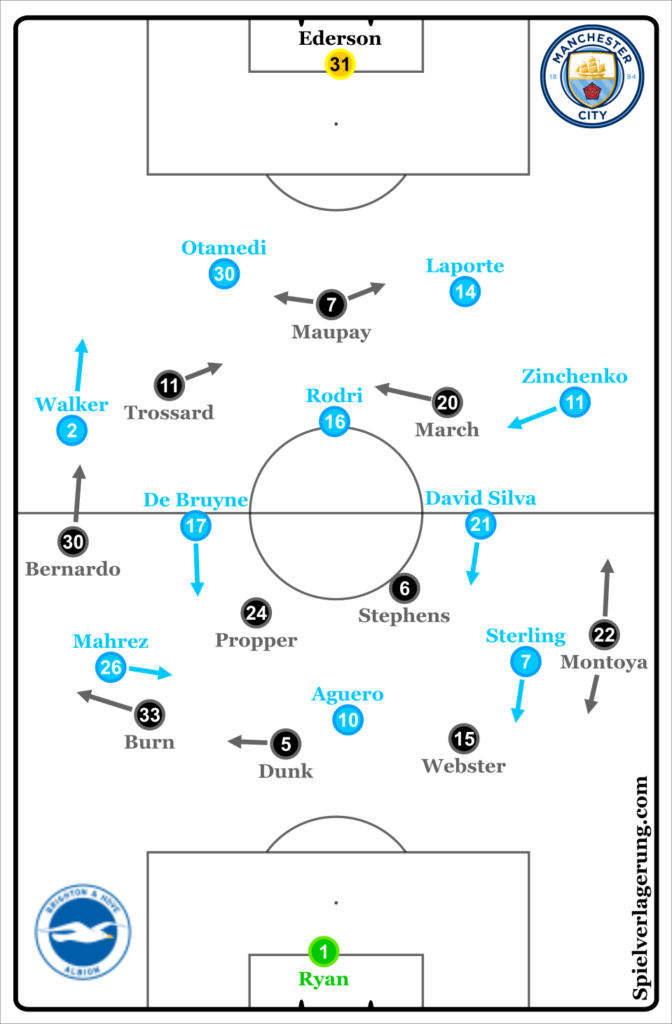
“Few teams come here to play with this courage and create chances”
“I think managers like Potter are very good for football”
And this wasn’t necessarily a suicidal match plan which allowed City to steamroll them either. The expected goals from various sources roughly has the numbers at 1.8 – 2.2 vs 0.8 – 1.2.
It’s also worth noting that in both games against Liverpool, Potter’s team played an expansive style of football which saw his team create good quality chances. Of course, it means that they lose the ball in transition and allow opportunities in that manner, but is that any more than teams who only defend their own third for 90 minutes?
In the recent game against Liverpool, Brighton almost matched Klopp’s team on xG, with 2.4 to 2.6. In the first leg, it was 0.8 to 1.3, with both Liverpool goals coming from set plays.
With a view to tonight’s match, I will attempt to analyse Brighton’s strategy in their match at the Etihad.
In Possession – Building with a Four
From their 5-2-2-1 base formation, Potter’s team built up with asymmetry in their first line. Left centre-back Dan Burn moved out to a typical left full-back position, with wing-back Bernardo moving higher. The two pivots, Stephens and Pröpper, stayed on the second line, with a narrow front three to pin their defenders back to try and create overloads in deeper positions. This build-up was acting against a fairly customary Manchester City 4-2-3-1 press. Their main method of breaking the press was to get one of their pivots free on the second line.
In their narrow front three, plus the high position of LWB Bernardo, Brighton looked to pin their opponents back four, as well as the two deeper midfielders acting in their 4-2-3-1 structure. Watching the game, I was rather surprised that both City pivots stayed quite deep in the build-up, in which was possibly an overly-cautious setup. Thus, by occupying roughly six Manchester City players with four, Brighton had an extra two players (plus the technically-comfortable goalkeeper Ryan) to find a way through.
To make the most of this overload, Brighton’s now-back four would position themselves wide to maximise the width in their own third and stretch City’s 3-1 press. This would make it very difficult for the ‘3’ to cover the width of Brighton’s pivots and full-backs. If the ball-near winger covered the ball-near Brighton full-back, attacking midfielder on ball-near pivot and Aguero splitting the centre-backs, the away side could consistently find one of the ball-far pivot or centre-back.
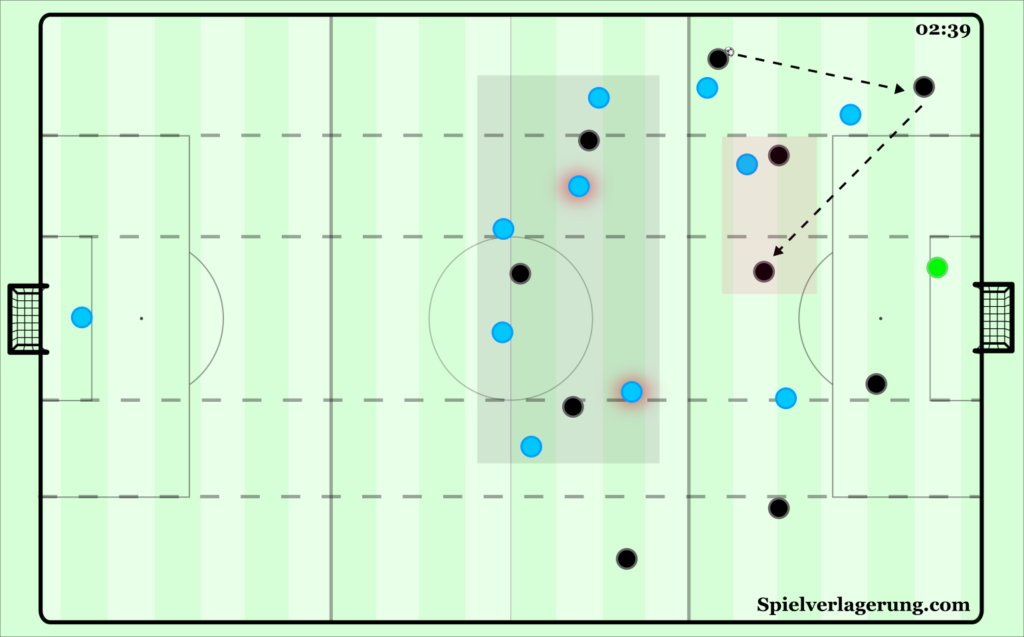
Of course, City could sometimes use their cover shadows to block these diagonal options and press three vs three. In these cases, Brighton had to be comfortable in playing three vs three in tight spaces to reduce this oppositional cover, and they largely did so with competence. Two main elements of their competence under pressure, was through maximising depth and use of movements against pressing in combinations.
As you can see from the above graph, Brighton were open to building from very deep, with the centre-backs sometimes on the byline. This gave City’s forwards longer distances to press, affording Brighton more time while also increasing the space to play through. In combining against the pressure, the full-backs would use clever ‘give and go’ actions where they would then run past the defender closing them down, allowing them to become free and receive in space.
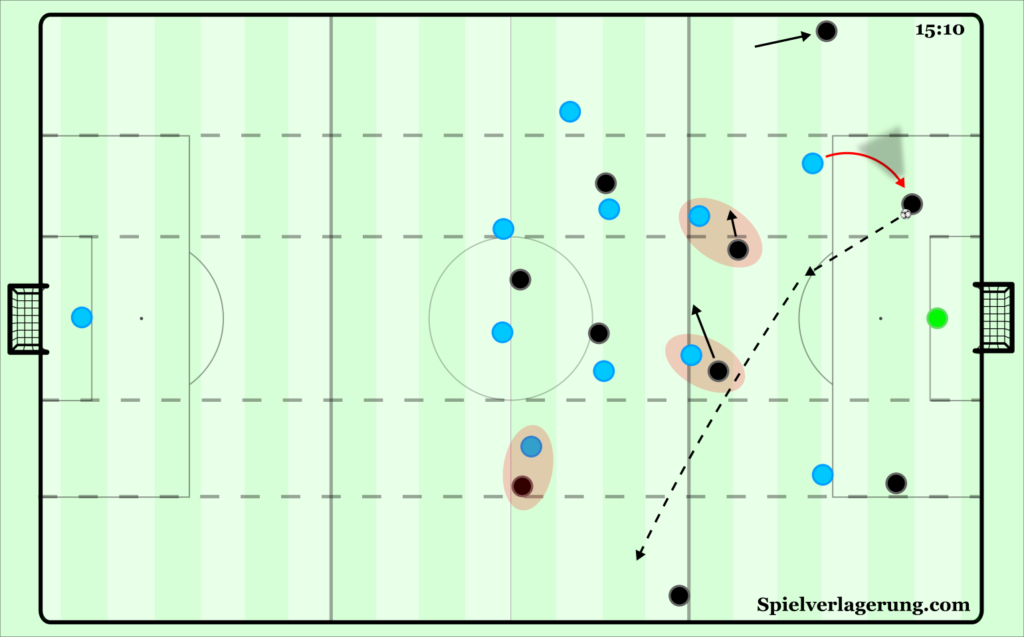
Following the first few situations, Manchester City seemed to adapt their press with Agüero taking a deeper starting position, closer to one of the pivots, with the wingers now higher and more oriented towards the CBs. In such situations, with the wingers higher and more central, it was now the Brighton full-backs who would be the free players instead of a pivot.
Now, facing pressure more from the outside than inside, Brighton’s centre-backs showed great competency in stepping-in with the ball to create the passing angle to play outside. With Aguero and attacking midfielder now deeper and oriented to the pivots, there was space central to step into, to ‘collapse’ the defence à la basketball before playing wide. You can clearly see the idea in the instance above, where both pivots move opposite to the dribble of Webster to give him more space.
An important element to this, as shown by the instance above, is the positioning of right-back Montoya. Through his deeper positioning, he forces Sterling to make a longer pressing approach to centre-back Webster, reducing his ability to press and giving the defender more time to step-in.
To find their full-backs effectively, it was important to do so with short build-up. In the situations where they played longer diagonal balls into the full-backs, the time the ball was in the air gave City’s defenders the opportunity to shift with the full-back jumping to create a duel.
While their pinning allowed for an overload of two in their first and second lines, naturally this meant they often could only attack with an underload once they did break the press. Consequently, they would then attempt to attack into open spaces, with long passes in-behind the City last line.
With a narrow front three, the forwards could work simple opposite movements to try and create gaps between the opposing centre-backs. Alternatively, although they mainly broke through down their left, if they beat the press down their right side, then left wing-back Bernardo became an option for a long diagonal ball.
Out of Possession – Forcing City to their Left
Without the ball, Brighton defended mainly in a lower defensive block. They would situationally move into high press, either from dead ball situations or on backwards passes, and they did so effectively.
It was their lower block which caused themselves issues however, starting with the first goal.
Their clear intention was to force City to build through Zinchenko, was was acting in his inside position from left-back. Solly March, Brighton’s nominal right-winger, had the simple role of man-marking City pivot Rodri in almost every situation. Centre-forward Maupay didn’t step wide to press the Ukranian, and Brighton’s pivots could hardly step out to engage him, with David Silva and De Bruyne acting on their blind-side.
Although they did have three centre-backs behind them, normally who could press any passes inside, they acted man-oriented and thus could be disorganised through simple movements.
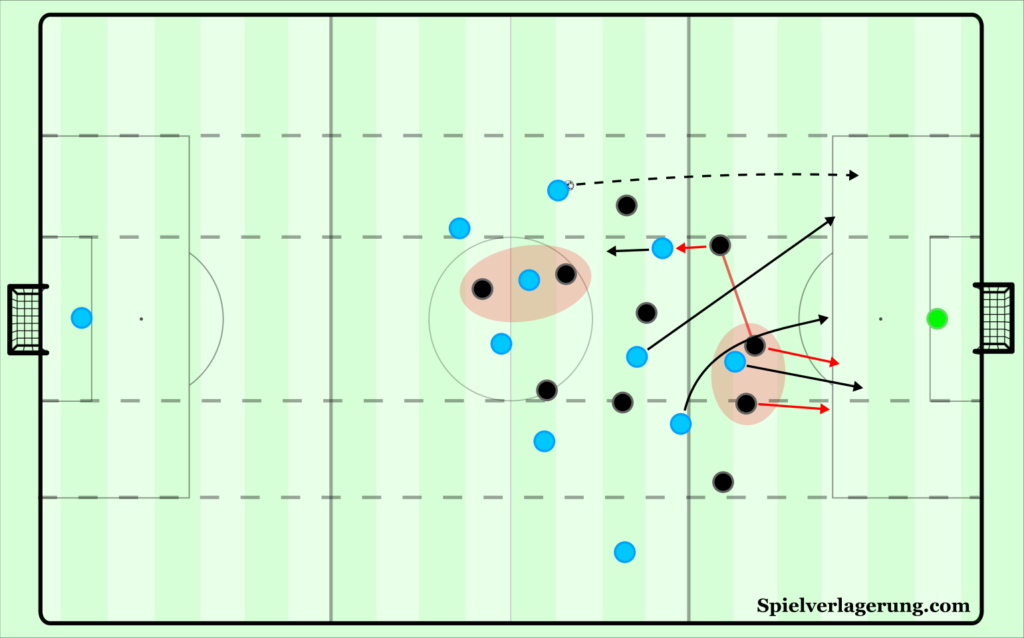
The combination of reactive defending in the last line and no pressure on Zinchenko – a competent passer – resulted in the first goal. Adam Webster followed Sterling into midfield, leaving space for David Silva to receive a pass in-behind from Zinchenko before cutting the ball back to De Bruyne.
Funnily enough, the 3-0 was also a result of Zinchenko having too much time, but in an entirely different context. In this situation, City were able to switch the ball from right to left through the unmarked Rodri. Due to Brighton’s narrow front three, Zinchenko then had a large space to drive into before finding David Silva between Brighton’s pivots, who could play first-time into Aguero who found the top corner.
City were able to create a number of other dangerous situations because of Brighton’s asymmetrical defensive shape which afforded Zinchenko with ample time in the left half-space.
More Effective High Press
Although I don’t think Brighton’s out of possession plan was effective within their own half, they were much more impressive when pressing the then-Champions.
Pressing in a 3-4-1-2 allowed Brighton to press man-for-man against City’s two centre-backs and pivot. Although pressing man-for-man has inherent disadvantages, it allowed Brighton to quite easily apply a high amount of pressure. While the ‘1’ of the pressing structure was man-marking Rodri, the front two pressed the centre-backs in a somewhat similar style to how Mané and Salah press for Liverpool. They pressed while using their cover shadow to block passes to City’s full-backs, which really limited the home-side’s options to play through the pressure and instead were forced back.
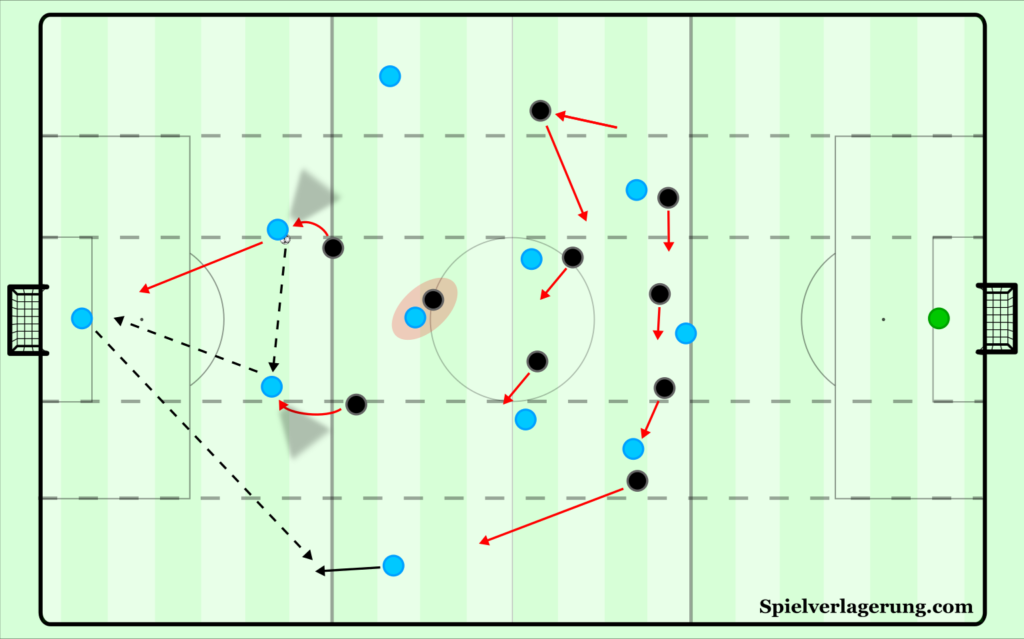
When the home side attempted to play short upon being forced back, Brighton forced them onto one side with their front three and the rest of the block shifted over excellently. This was particularly the case across the back five, as the ball-near wing-back was required to step up high to City’s full-back and the ball-near CB to the City winger. On the other side, the ball-far WB had to take a narrow position to allow both the midfield line and defensive line to shuffle across to cover sufficiently.
The anticipation of the front three in stepping up on the earliest ques was a key part in forcing City into playing a number of long balls.
Counter-Attacking Opportunities
Naturally, transition situations against Manchester City are often a decisive factor of the game. While Potter’s side had a number of promising opportunities to counter-attack, they could have been more effective when breaking forwards. Their defensive shape with three fairly high players, gave them a good structure to transition from against City’s ever-expansive in-possession structure.
Surprisingly for an away team at the Etihad, they actually turned down a number of opportunities to start a counter-attack, instead looking to play backwards and build-up again. And although their build-up was good, they certainly passed up on more promising situations when City’s shape was disorganised.
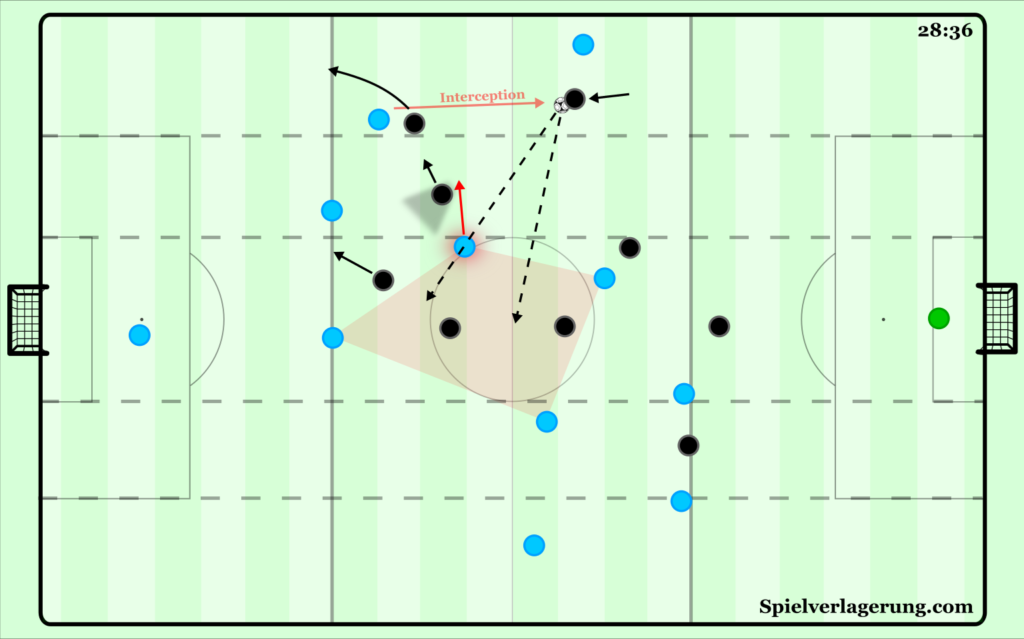
The other big theme of Brighton’s lacking potential in counter-attacking situations was their inability to find the ball-far option of the front three. As a general note on counter-attacking, the most effective strategies often play on the typical behaviour of defenders in transitional situations. Whereas in structured play, the reference points for defensive positioning are more defined, players seem to be far more ball-oriented in the seconds following a turnover as they ‘swarm’ the options around the ball.
Therefore, a generally more successful strategy is to immediately search the ball-far spaces, thus attacking the blind-side of defenders rushing towards the ball. In the case of Brighton, this would have typically been a pass into the ball-far winger. However, Potter’s men mainly looked to progress down the side of the pitch that the ball was won in. This allowed City’s defenders to show them outside, recover positions centrally and diffuse the situation.

More recently, Brighton looked far better on counter-attacking situations in their midweek game against Liverpool. Albeit mainly already at 0-2 after a fairly calamitous start, Brighton were able to play forwards more quickly and find their centre-forward or ball-far winger to exploit the spaces that Liverpool left in the transition defending.
Conclusion
Revisiting Guardiola’s post-match comments, the match was certainly not a 4-0 game. And this was not necessarily because Man City played badly, but their opponents were set-up very well.
In possession, they broke down City’s press in an effective and structured manner with the use of pinning by their forwards and adaptive play under pressure to find the free-man within their own half. Without the ball, they showed great promise in their pressing game, despite an unsuccessful approach to defending in a more passive block.
With Brighton now positioned eight points above the relegation zone, the Southern club should be feeling relatively safe. Looking towards their match against Guardiola’s team tonight, they will certainly be looking to replicate the level of their performance from their first meeting and their recent game against Liverpool and hope that fortune favours them well. Regardless of the result, I’m expecting to see another interesting, but irrelevant game.
Keine Kommentare vorhanden Alle anzeigen